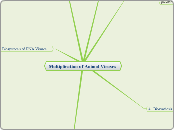Multiplication of Animal Viruses
1. Attachment
attachment sites are distributes all over virus
adenovirus--icosahedral--small fibers at corners
enveloped--influenza--spikes
receptor sites are inherited characteristics of the host
receptor forparticular virus varies from person to person
2. Entry
by pinocytosis
enveloped viruses can enter by fusion: envelope fuses with PM and releases capsid into cell's cytoplasm
HIV
3. Uncoating
separation of viral nucleic acid from it's protein coat once the virion is enclosed w/in vesicle
poliovirus--uncoating starts to happen while virus is still attached to PM
4. Biosynthesis of DNA Viruses
Herpesviruses
papoviruses
Adenoviruses
Hepadnaviruses
1-2. viral DNA released into the nucleus of host cell
3. transcription of viral DNA...translation..
4. transcription and translation of "late" viral genes...capsid and structural proteins
5. synthesis of capsid proteins in cytoplasm
6. maturation...assembles to form complete viruses
7. released from host cell
DNA Viruses
Adenoviridae: common cold
Poxviridae: skin lesions--cow pox and smallpox
Herpesviridae: spreading appearnce of cold sores
Simplexvirus: cause cold sores
Varicellovirus: chickenpox
Lymphocryptovirus: infectious mono
Cytomegalovirus: CMV Inclusion Disease
Roseolovirus: Roseola
Kaposi's sarcoma, primarily in AIDS patients
Papovaviridae
name from papillomas (warts), polomas (tumors) and vacuolation
some Papillomavirus can ause cancer
Hepadnaviridae
cause hepatitis and contain DNA
synthesize DNA by copying RNA using viral reverse transcriptase
4. Biosynthesis of RNA Viruses
multiply in host cell's cytoplasm
Picornaviridae
poliovirus
single-stranded RNA
smallest viruses
RNA w/in virion is callsed sense strand because it can act as mRNA
new strand is antisense strand
contain RNA dependent RNA polymerase
Togaviridae
arthropodborne, arboviruses or alphaviruses
contain singe sense strand of RNA
enveloped
Rhabdoviridae
rabiesvirus
bullet-shaped
single antisense strand of RNA
contain RNA dependent RNA polymerase
Reoviridae
respiratory and enteric systems
double stranded RNA
contain RNA dependent RNA polymerase
Retroviridae
infect vertebrates
Lentivirus
carry reverse transcriptase which uses viral RNA as template and degrades original viral RNA
integrated into host cell chromosome as a provirus which gives it protection from antivieral drugs
in oncogenic retroviruses the provirus can convert host cell into a tumor
5. Maturation and Release
starts with assembly of protein capsid
envelope develops around capsid by budding
capsid pushes through PM..buds...cell usually doesn't die
nonenveloped released thru ruptures in OM...leads to cell death
